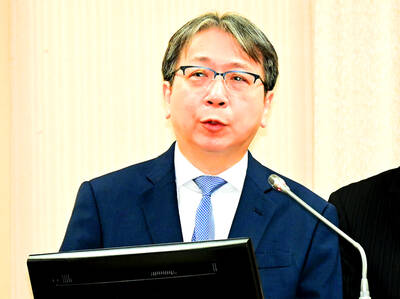The Ministry of National Defense on Monday denied reports that the armoring on the domestically produced CM-32 Clouded Leopard personnel carrier, which entered mass production in late 2010, was below standard.
The Chinese-language Apple Daily said ballistic resistance live-fire tests in March 2010 showed that the armor plating on the Clouded Leopard does not comply with the bulletproof specifications set by the military. Puncture holes were observed on an armored panel at the rear of one of the vehicles, it said, adding that this raised questions about the armor’s ability to protect personnel on board.
The eight-wheeled, 25-tonne Clouded Leopard armored vehicle is a joint project between the Ordnance Readiness Development Center and the Chungshan Institute of Science and Technology (中山科學研究院).

Photo: Chan Chao-yang, Taipei Times
In a press release on Monday, the ministry denied that the armor plating, which is also domestically produced, was not up to standards and said the armoring, which had been tested several times, complied with specifications.
The front plating of the vehicle is designed to withstand 12.7mm machine gun and armor-piercing incendiary (API) ammunition, while the side and rear sections provide protection against 7.62mm ammunition and small arms fire.
Commenting on photographs showing holes in the rear of the vehicle following the ballistic test, the military said a 12.7mm API round missed the targeted front arc plate and, as the engine hatch plate was not installed during the test, the round passed through the engine compartment and penetrated the rear plate instead. It added that since the damaged rear plate was not designed to resist a 12.7mm round, the result was invalid.
It is important to distinguish between the armor requirements for the front of the vehicle and those for the side and rear, it said.
The armoring complies with the operational needs set by the army, it said, adding that if necessary, ceramic armor could be added to increase protection.
However, some military analysts have said that questions remain over the results of subsequent tests and how the engine hatch plate would perform against 12.7mm API.
Initiated in 2005, production of the CM-32 faced a number of problems during development and at one point came close to being shut down amid controversy over procurement, a budget freeze and the vehicle’s failure during a demonstration in January 2005 to ascend a 70-degree slope. Later on, chassis cracks in several of the initial 14 vehicles also threatened further delays, though the Armaments Bureau in May last year said the problem had been fixed and the program remained on schedule.
Mass production, initially scheduled for 2007, began in November 2010, with the army set to procure 650 CM-32s for NT$58 billion (US$1.8 billion) to replace ageing M113s and V-150 armored vehicles.
With translation by Stacy Hsu, Staff Writer

The US government has signed defense cooperation agreements with Japan and the Philippines to boost the deterrence capabilities of countries in the first island chain, a report by the National Security Bureau (NSB) showed. The main countries on the first island chain include the two nations and Taiwan. The bureau is to present the report at a meeting of the legislature’s Foreign Affairs and National Defense Committee tomorrow. The US military has deployed Typhon missile systems to Japan’s Yamaguchi Prefecture and Zambales province in the Philippines during their joint military exercises. It has also installed NMESIS anti-ship systems in Japan’s Okinawa

‘WIN-WIN’: The Philippines, and central and eastern European countries are important potential drone cooperation partners, Minister of Foreign Affairs Lin Chia-lung said Minister of Foreign Affairs Lin Chia-lung (林佳龍) in an interview published yesterday confirmed that there are joint ventures between Taiwan and Poland in the drone industry. Lin made the remark in an exclusive interview with the Chinese-language Liberty Times (the Taipei Times’ sister paper). The government-backed Taiwan Excellence Drone International Business Opportunities Alliance and the Polish Chamber of Unmanned Systems on Wednesday last week signed a memorandum of understanding in Poland to develop a “non-China” supply chain for drones and work together on key technologies. Asked if Taiwan prioritized Poland among central and eastern European countries in drone collaboration, Lin

TRAGEDY STRIKES TAIPEI: The suspect died after falling off a building after he threw smoke grenades into Taipei Main Station and went on a killing spree in Zhongshan A 27-year-old suspect allegedly threw smoke grenades in Taipei Main Station and then proceeded to Zhongshan MRT Station in a random killing spree that resulted in the death of the suspect and two other civilians, and seven injured, including one in critical condition, as of press time last night. The suspect, identified as a man surnamed Chang Wen (張文), allegedly began the attack at Taipei Main Station, the Taipei Fire Department said, adding that it received a report at 5:24pm that smoke grenades had been thrown in the station. One man in his 50s was rushed to hospital after a cardiac arrest

ON ALERT: Taiwan’s partners would issue warnings if China attempted to use Interpol to target Taiwanese, and the global body has mechanisms to prevent it, an official said China has stationed two to four people specializing in Taiwan affairs at its embassies in several democratic countries to monitor and harass Taiwanese, actions that the host nations would not tolerate, National Security Bureau (NSB) Director-General Tsai Ming-yen (蔡明彥) said yesterday. Tsai made the comments at a meeting of the legislature’s Foreign Affairs and National Defense Committee, which asked him and Minister of National Defense Wellington Koo (顧立雄) to report on potential conflicts in the Taiwan Strait and military preparedness. Democratic Progressive Party (DPP) Legislator Michelle Lin (林楚茵) expressed concern that Beijing has posted personnel from China’s Taiwan Affairs Office to its